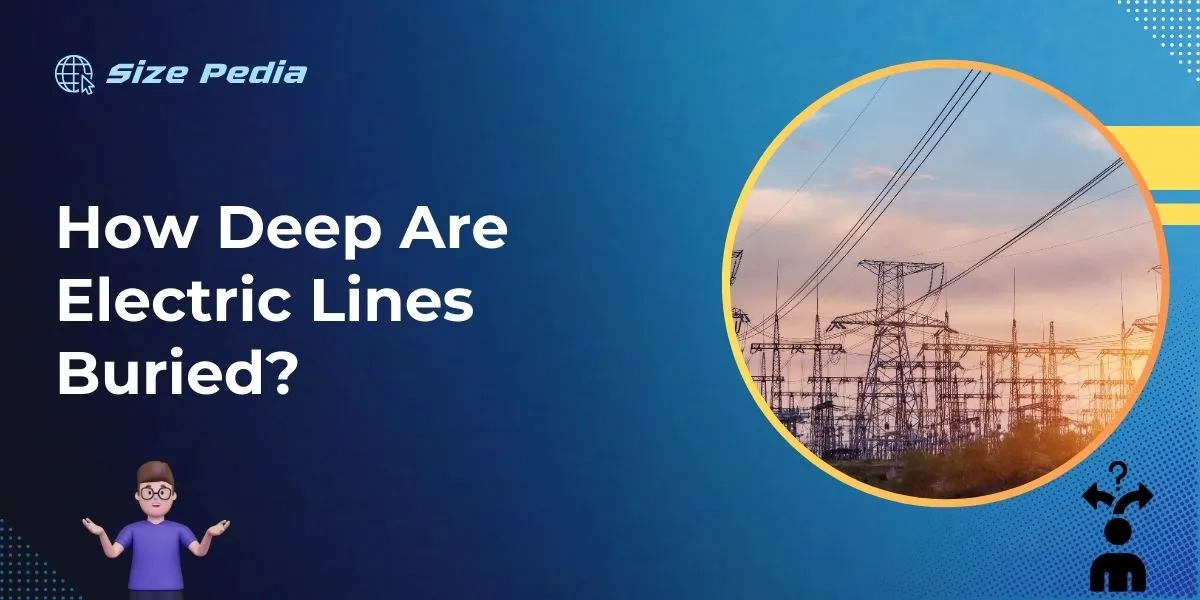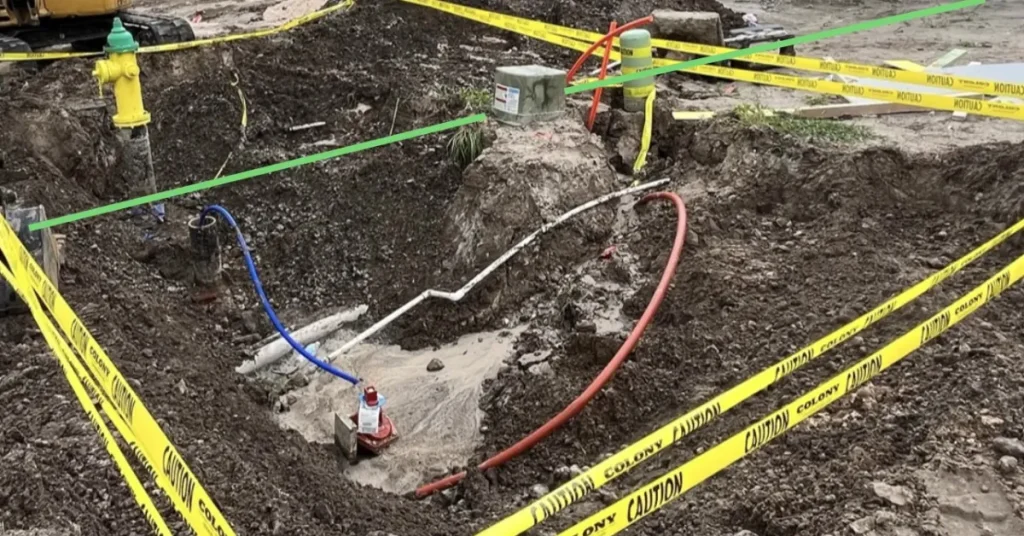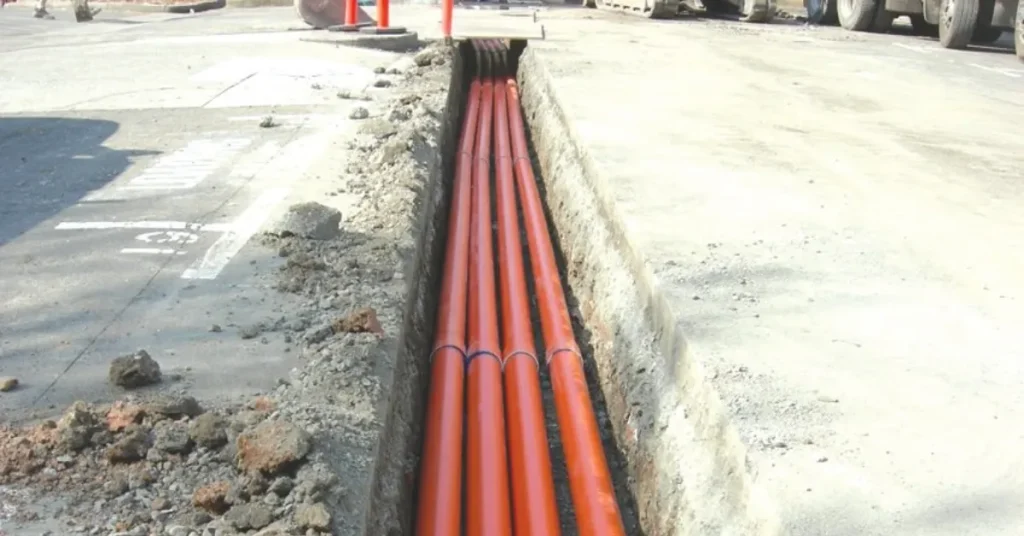Electric lines are typically buried at a depth of 18 to 24 inches. National codes such as the National Electric Code (NEC) often govern these standards.
Buried electrical lines are an essential component of our infrastructure, quietly powering our homes and cities without marring the landscape. The depth at which these utilities are placed is not arbitrary; it is a carefully considered safety measure.
With specific regulations in place to protect both the public and utility workers, the practice of burying electric lines minimizes the risk of accidental dig-ins, ensuring consistent and reliable power distribution.
Homeowners planning to dig in their yards for various projects must consider these guidelines and are encouraged to call 811 to have utility lines marked to prevent accidental disruption.
This standard protects the intricate network of electricity that runs like the lifeblood beneath the surface, powering our modern conveniences.

Digging Into Safety: Electric Line Depths Unearthed
Let’s wade into “Digging Into Safety: Electric Line Depths Unearthed”. Knowing how deep electric lines are buried keeps us safe. Electric line depths are not just random but follow strict rules. Let’s explore why this matters and the rules that guide how deep they go.
The Importance Of Burying Electric Lines
Electric lines flow with energy we can’t see. They stay hidden under the ground for three reasons:
- Safety: Deeper lines prevent accidents and protect us.
- Reliability: Wind and storms don’t reach underground lines. This keeps our lights on.
- Beauty: Hidden lines mean a clear view. No poles or wires to block the sky.
Regulatory Compliance And Depth Standards
Rules guide how deep lines must be buried. A group called the National Electric Safety Code (NESC) decides this. Each type of electrical line has its own depth:
| Type of Electric Line | Depth (inches) |
| Residential | 24″ |
| Commercial | 36″ |
| High Voltage | 48″ or more |
All local codes also add rules. Always check these before you dig.
Zones Of Influence: Understanding Soil And Electrical Safety

The safe installation of electric lines requires a keen understanding of the surrounding environment, specifically the soil. This is critical to ensuring both the longevity of the electrical infrastructure and public safety.
Each type of soil influences how deep electric lines should be buried. In the zones of influence, soil composition and electrical conductivity are two paramount factors.
Soil Types And Their Impact On Line Burial
Different soil types affect depth requirements for buried electric lines:
- Sandy soils enable easier digging, thus lines may be deeper.
- Clay soils, dense and heavy, can protect lines at shallower depths.
- Rocky soils often require alternate burying techniques due to difficulty in trenching.
Electrical Conductivity And Safety Concerns
The soil’s ability to conduct electricity influences safety measures:
| Soil Type | Conductivity |
| Moist soil | High |
| Dry soil | Low |
A higher moisture content raises conductivity, which could lead to danger if lines are not buried deeply enough. Electrical lines need a balance of depth and insulation to prevent accidents and ensure uninterrupted services.
Voltage Variations: Depths For Different Electric Lines
Understanding the depth at which electric lines are buried is crucial for safety and compliance with regulations. Different voltages require electric lines to be at varying depths underground.
This helps to protect the cables from damage and reduces the risk of accidents. Let’s dig into the specifics of how deep electric lines must go, depending on their voltage and purpose.
Residential Vs. Commercial Electric Line Requirements
The needs for residential and commercial electric lines differ. Residential lines usually carry less voltage. They are buried to a standard depth of about 24 inches.
This is set by the National Electrical Code (NEC). Commercial lines, which often carry a higher voltage, must be buried deeper. They can go as deep as 36 inches or more to meet safety guidelines.
- Residential Lines: Approximately 24 inches
- Commercial Lines: At least 36 inches
High-voltage Networks: An Exceptional Case
High-voltage lines are an important case. These lines power cities and regions. They need special treatment. The rules for these lines are strict. They must be placed well below ground, far from reach.
| Voltage Level (kV) | Minimum Depth (Inches) |
| 50 kV to 200 kV | 48 inches |
| Over 200 kV | 60 inches or deeper |
Local regulations may enforce deeper burials. Always check and follow these rules.
Hazards Of Shallow Trenches: Risks Of Inadequate Burial
Understanding the risks involved with shallow electric line trenches is critical. The proper depth of these trenches is not just about meeting regulations. It balances the need for practicality against potential dangers. Inadequate burial can lead to severe consequences.
Damage Prevention To Buried Electric Lines
Electric lines buried too close to the surface are vulnerable. Physical interference is often accidental. From gardening mishaps to construction projects, disruptions can be costly.
- Burial depth acts as a protective buffer, guarding against unintentional damage.
- Properly buried lines remain safe from everyday activities.
- Outline clear safe digging practices to protect buried lines. This ensures operational efficiency.
Public Safety And Accident Prevention
Shallow trenches put the public at risk. Electric shock and tripping hazards increase significantly with improperly buried lines.
| Shallow Trench Risk | Consequence |
| Electric Shock | Possible injury or fatality |
| Tripping Hazard | Potential accidents and injuries |
| Line Exposure | Increased risk of electrical faults |
Adhering to depth standards minimizes these risks, creating a safer environment. Regular audits and maintenance ensure continual public protection.
Advanced Technologies: Tools For Ensuring Safe Line Burials
Underground electric lines require careful installation. Proper depth is critical for safety and functionality. Advanced technologies play a big role in burying electric lines safely. These tools help locate existing lines and ensure new installations are at the correct depth.
Ground Penetrating Radar And Its Applications
Ground Penetrating Radar (GPR) is a powerful tool for underground utility detection. Let’s explore how GPR ensures that electric lines are buried safely:
- Detects buried utilities: GPR sends radar waves into the ground. It detects objects and changes in material.
- Prevents accidents: It helps to avoid digging into existing lines.
- Maps underground: GPR can create maps of what’s beneath the surface. This helps in planning where to bury new lines.
Smart Sensors And Monitoring Electric Line Depth
Smart sensors ensure that electric lines are at the right depth over time. Here’s how they maintain line safety:
- Constant tracking: Sensors attached to electric lines send data about their depth.
- Alerts for shifts: If lines move from the original depth, sensors alert utility companies.
- Data for maintenance: Consistent monitoring helps in making decisions about line maintenance.
With smart sensors, we keep electric lines at a safe depth for years.
Digging Protocol: Best Practices For Excavations Near Electric Lines

Digging near electric lines requires careful planning. This ensures safety and avoids service disruptions. Following recognized protocols for excavations is crucial.
Call Before You Dig: The 811 Rule
The 811 rule is a must for any excavation work. It’s simple: call 811 before you start. This service tells you where underground lines are. It helps keep you safe. It’s a free service.
- Dial 811 at least a few days before digging.
- Wait for the site evaluation.
- Mark the utility lines on your dig site.
Professional Excavation And Handling Techniques
Professionals know how to handle digs near power lines. Safety and technique are key. Here are best practices:
- Locate lines first: Use the information from the 811 service.
- Use proper tools: Pick tools that match the job’s needs.
- Follow safety standards: Wear safety gear and follow protocols.
- Monitor the area: Keep checking for signs of buried lines.
Experts use equipment like ground-penetrating radar (GPR). This finds hidden electric lines. Their methods prevent service issues and accidents.
FAQs About How Deep Are Electric Lines Buried
How Deep Should Electric Lines Be Buried?
Electric lines should be buried at least 24 inches deep. This depth can vary based on the type of electrical cable and local regulations. Always check with your local utility company for specific guidelines.
What Factors Affect The Burial Depth Of Electric Lines?
Burial depth for electric lines depends on several factors. These include the type of electrical cable used, local building codes, and the presence of other underground utilities. Ground freezing depth and soil type also play a role.
Is It Safe To Dig Above Buried Electric Lines?
No, it’s not safe to dig above buried electric lines without taking proper precautions. Always call 811 before you dig to have utilities marked. This helps prevent accidentally hitting underground lines, which can cause harm and outages.
Can Electric Lines Be Buried Directly In The Ground?
Some electric lines can be buried directly in the ground if they’re rated for direct burial. Others may require protective conduit. Always follow manufacturer specifications and local codes for safe installation.
Conclusion
Understanding the burial depth of electric lines is crucial for safety and compliance with local regulations.
The standard depths vary, influenced by factors like local codes and the type of electrical line. To avoid hazards, always consult a professional before digging.
Remember, knowledge and caution are key in handling underground electrical installations.
Resources:
1. https://www.fema.gov/case-study/overhead-underground-it-pays-bury-power-lines
